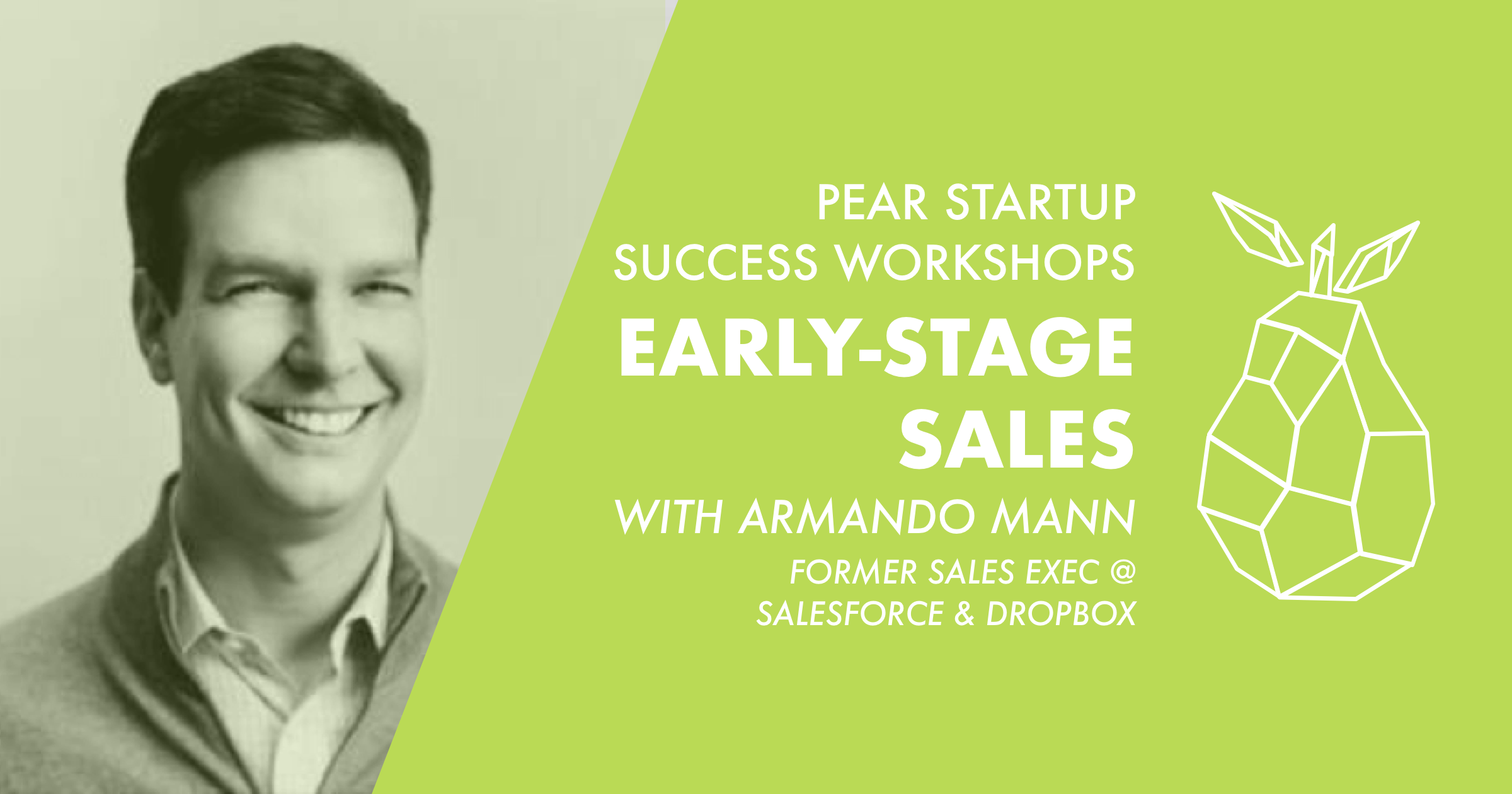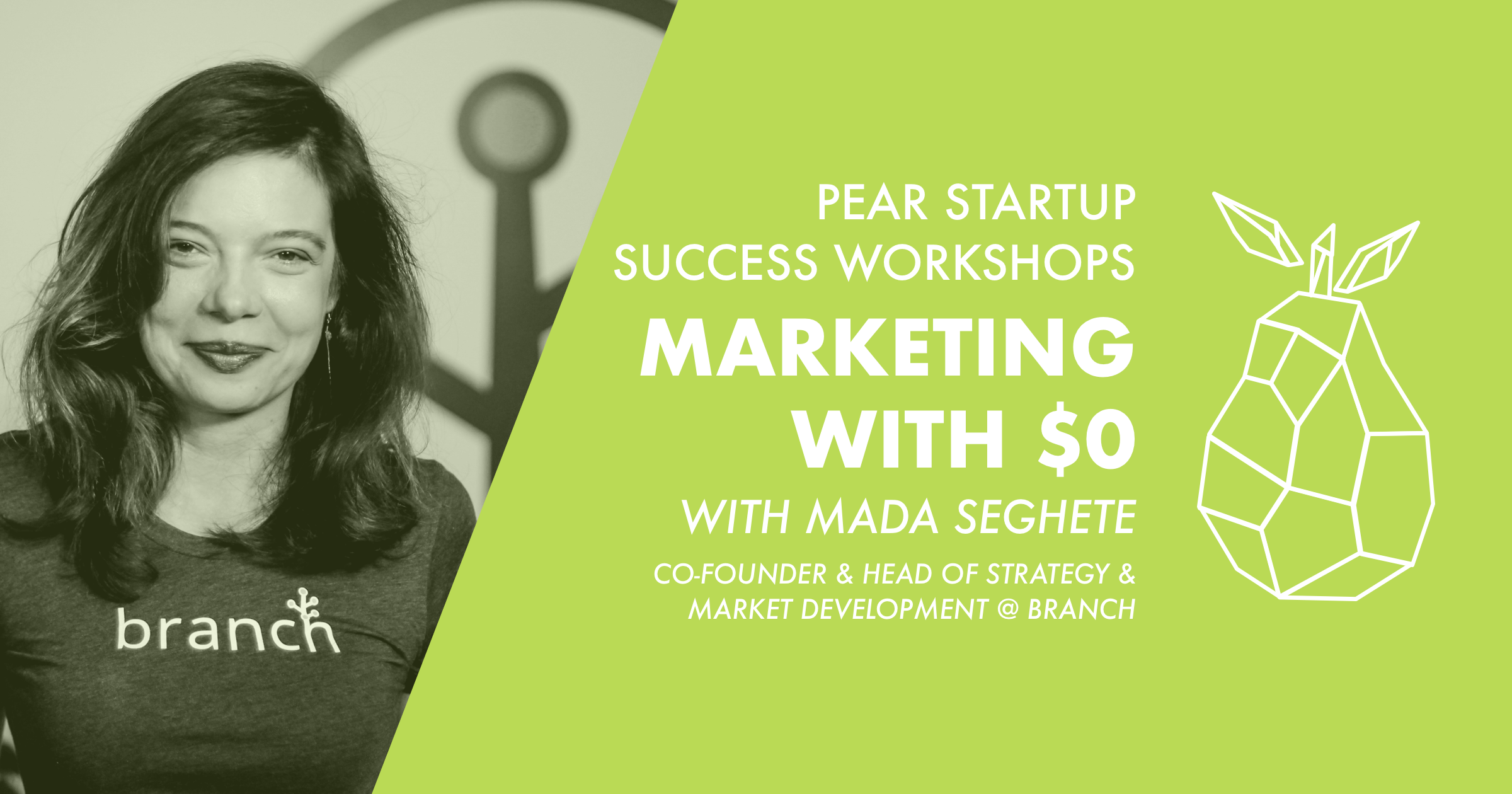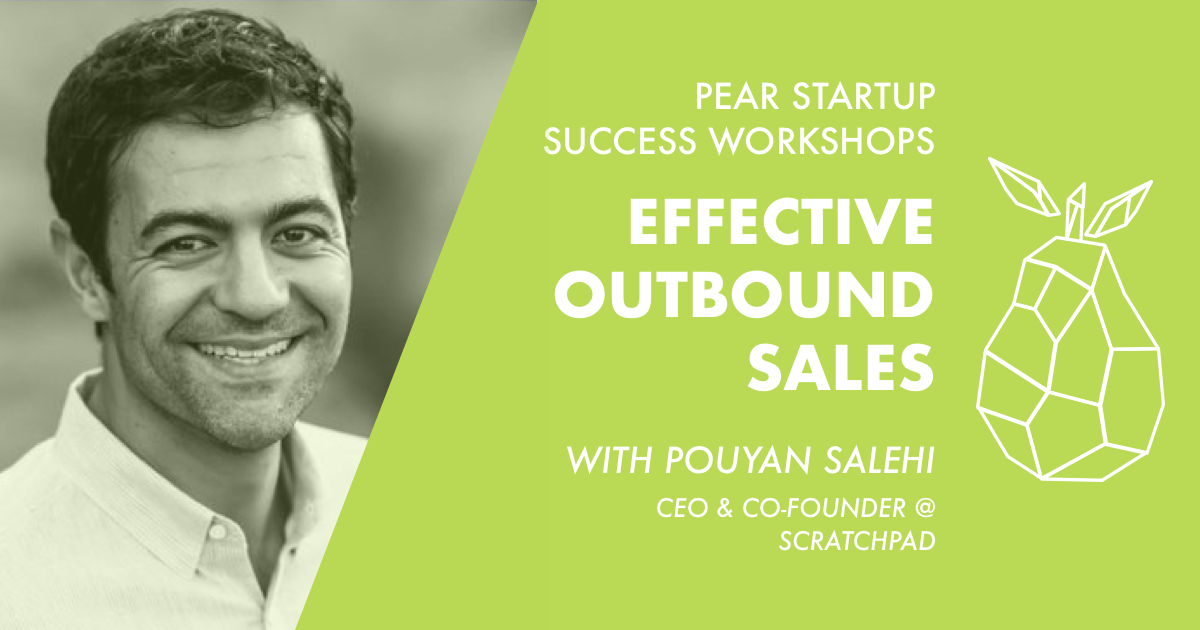Armando Mann, angel investor and former Sales VP at Salesforce, Dropbox, and Google hosted a talk discussing the nitty gritty of building out your sales strategy and team on April 1st, as part of the Pear’s speaker series. This is a recap!
Watch the full talk at pear.vc/speakers, and RSVP for the next one on product management: August 18th with Nikhyl Singhal, VP of Product at Facebook.
You’ve built a product that has the potential to disrupt an entire industry, and now you need to get into the hands of customers. How can you do that strategically, and how do you build a team that can execute your strategy? Armando walks us through it all, step by step, with all the nitty gritty details you need.
Choosing Your Market Maximizing Your Wins Building the Machine Set Up for Success Key Takeaways
Choosing Your Market
Many founders think that the way to find product market fit is to distribute their product to as many people as possible and then see which groups are working out best. Armando advises against this.
“You never know who to hear or who to listen to when you’re getting feedback,” he explains.
Instead, you want to approach finding product market fit with a hypothesis of what problem you’re solving and for whom, and try to talk to the smallest, most narrow group of people that fit the bill. This might seem counterintuitive if you’re trying to build a big, category defining business, but starting small actually allows you to grow fast, if you choose carefully.
At Armando’s startup, RelateIQ, the team went looking for a market that they could win 9 out of 10 times, and that could grow and bring the company upwards. They considered their product carefully and kept narrowing and narrowing their target:
- First, the team considered which workflows their product could support. Sales workflows were the best fit.
- Tracking was the only feature their product had at the time (no advanced forecasting or revenue reporting). They knew this feature was valuable only to recruiting or partnership teams.
- They didn’t want RelateIQ to be a recruiting tool. This narrowed the field to partnership focused teams.
- The product only worked with Gmail. So, they could only serve partnership teams who worked in Gsuite. These were likely to be tech companies.
- The product’s novelty, at the time, was the capability of extracting data from email, so customers would need to be comfortable giving access to their emails.
- Finally, big companies would want various controls that the product could not provide. They would need to go after smaller businesses.
Taking all these factors into consideration, the RelateIQ team determined their target market: business development teams and tech startups with under 100 employees.
“That business could have been small and we would have died a small death in a niche market that was irrelevant, if that had been our only market,” Armando acknowledges.
But the RelateIQ team had a clear plan for how to grow quickly from that narrow market into the adjacent markets.
“We knew what features we needed to go from partnerships to account management within a company. Then we also knew how to go up market from under 100 employees to under 1000 employees,” says Armando. “So, as we moved along the axes, we would unlock little pieces of the market to give us this beautiful up and to the right chart where every group was growing.”
Focusing on narrow markets has the benefit of forcing focus and tighter referral loops. Once you’re growing in a niche, your cost of acquisition in that niche goes down, and you can afford to reinvest those savings into your next niche.
In sum: try to find your smallest possible market. It could be geographic. It could be the tech stack. It can be any dimension. Make your product incredible for that small group of people. Then, focus product marketing, sales, everybody, to go after that market.
“You have to be very clear, this is not a sales strategy, it’s a company strategy,” says Armando.
Once you have nailed that market — you’ve figured out the cost of sales, your sales cycle, all your key metrics, and they are in a healthy place, i.e. predictable and repeatable — you can seed the next one.
Note that whether you start down market and move up market or the opposite way doesn’t matter. The point is to figure out how to dominate a sub-piece of a market that can feed into adjacent markets.
“There’s not a bad market to go after first as long as these are customers that can stay with you,” Armando notes. “It depends on the strength of the entrepreneur, what you’re comfortable with and who you want to solve this problem for first.”
Maximizing Your Wins
Like many salespeople, when Armando first started in sales, he was introduced to the big myth of “Always Be Closing.” It was one of the biggest things that he had to unlearn.
“I thought you always wanted to get new customers, that was the thing. But that’s not right. In SaaS, renewals and customer success beat new business 10 to 1 every day,” says Armando.
That’s because great retention and upsells compound, so a small improvement in these metrics has a much bigger impact on ROI than a small improvement in acquisition. While the first few years of this strategy might not look too sunny, over time, if you hit your targets, you will fly past your competitors.
Armando recommends that you not worry too much about how you will raise prices over time for your first customers, and focus instead about how pricing will affect your next customers.
“Those first customers, you can always say, ‘Hey, this is the pricing. We’re new, we’re starting our business. Here’s what we aspire to charge,’ and then there’s a negotiation. You say, ‘We can do this for this year, and chat again at the end of next year at renewal time, or we can do a three year contract and lock in this price for the next three years. We’re not going to be a great company just by getting an extra 10, 20% from you every year. Wwe want to make sure that we have a long term relationship with you.’”
Make sure both your account executives and customer success managers take interest in the success of upsells.
Building the Machine
Hire a Customer Success Manager from Customer Number One
A strategy is nothing without execution, so it’s critical to think through how you will build and structure your sales team to accomplish the plan.
The first thing is to have Customer Success Managers. It may seem like a good idea for you as the founder to take on this role, but Armando advises against this, as founders usually need to be ahead of the curve and focusing on hiring, fundraising, and selling. Armando recommends you have a Customer Success Manager onboard from customer number one.
“That is the first group of customers that hits the one year renewal date. And that’s the data that VCs will look at after a year and say, ‘Show me your first customers. What happened in the last year?’ You could go and say, ‘We’re great now, cohorts are getting better and better. Those were just a bad fit, just don’t look at our data from our early customers,’” says Armando.
“It’s so much more powerful to say, ‘Look, these first customers, none of them have churned and they’ve grown to extra spending the last year and you can call any of them and see how things have gone over the last year.’ That’s a way better story. So from the beginning I would spend an enormous amount of time on my existing customers.”
A good ratio early on is one Customer Success Manager for every two Account Executives. When scaling, aim for one Customer Success Manager for every 1 or 2 million dollars of recurring revenue.
What to Look For In Your Account Executives and Customer Success Managers
For account executives in the early stage, you’ll want to be looking for athletes — “People that can build the plane as you’re taking off.” When you’re scaling, you’ll want to start looking for candidates with a track record of scaling with a company and can leverage all the structured resources that come with scale.
Let’s call the early stage account executives Jane, and the scale stage account executives Jack. Here’s what they might look like as candidates:

The characteristics you are looking for in customer success managers as compared to account executives are actually very similar to the above. The difference comes in their respective motivations.
Armando’s uses a very simple test: say your employee gets an email from a customer at 11:00 PM at night before they go to bed, after watching something on Netflix. Both will respond to that email (though you might tell them not to and just wait until the next day!).
“The AE will do it because of the leaderboard, because of the competition. They want to close that deal.
The CSM will respond to that email because of empathy. They feel the pain of the customer. They’re like, ‘If I don’t respond to this person, they will have to wait 10 or 12 hours until I get to the office and go through my meetings and get to this email. If I respond to this email right now, I’m putting them out of their misery and just helping them out with this one problem. That one short email from me will help them unblock today.’”
Where to Find Your Early-Stage Account Executives and Customer Success Managers
Armando recommends a few sources to find the right early-stage hires, your Janes:
- Unsatisfied large tech company sales professionals: “You’re looking at people that went to a large company because they thought they wanted to be in sales and they got the training and realized they didn’t like the structure and the constraints that came with being in a large company. They didn’t necessarily like the certainty that comes from knowing exactly what they had to deliver every few months.” Note that Jack candidates do love this.
- Former entrepreneurs: “I don’t think there’s better sales training than being an entrepreneur, so bring those folks in who will appreciate that you have a product that you can sell and that there is traction. They were some of the most loyal sales folks I’ve hired because they understand how difficult it is, what you’re doing as an entrepreneur. They can empathize and they know what they need to deliver for you.”
- Business development, private equity, or venture capital professionals: “They have a lot of acumen. They have to hustle to get into certain deals. They have to be creative. There’s no playbook.”
If you’re looking for Jacks, you’ll want to investigate sales candidates who have spent 3–10 years at large companies (either one, or several) developing their skills. You can also find them in lateral industries. For example, if you are a FinTech entrepreneur, you might try to look for sales professionals in commercial banking instead of in tech. These professionals will already be well-trained in the fundamental principles of successful sales, and all you’ll have to do is to teach them the technology side of it.
Don’t worry too much about industry expertise. Unless your product is in a regulated industry or a very hardcore technical product, your hire should be smart and able to learn quickly.
“I would rather bring somebody that has all the other characteristics that you want in your company — a teammate that will connect with your company really quickly and in a positive way and add to your culture.”
A great way to source for such high potential candidates is to ask for referrals from your engineers. Ask who they might have met at their prior companies in sales.
“Most would be like, ‘I never met one. Sales? I don’t know those people, they’re in different building.’ But if they met somebody, that in itself is rare enough that you would take that as a huge plus — that this salesperson was able to connect with engineers or with PMs or with other teammates.”
Moreover, if they’re hired, they also will now have a friend and built-in sponsor inside your company.
Set Up for Success
Onboarding
When you’ve got great candidates, you want to make sure that they are able to work as well as possible with your existing team. Armando goes as far to make sure that high potential candidates meet over 10 to 12 people early on in the interview process.
“It’s a massive overkill, unless you realize that what you’re building is a group of folks who are all collectively responsible for this hire. So when this person joins, they all feel a level of connection or responsibility for this person’s success, which is incredibly valuable.”
Once the candidate joins, do all you can to help them form connections as quickly as possible — scheduling breakfasts for them, assigning them lunch buddies, etc.
“At a high growth startup after months two and three, you cannot claim you’re a newbie and you want to connect with somebody because you haven’t met them before,” says Armando. “You need to build the network in the first few weeks when you don’t have a quota, you’re still learning, and meeting people is part of your job. Make that something structured in the onboarding process.”
Organization
Founder CEO’s tend to think of their sales process in a linear funnel, and thus often set up their sales teams in a straight line as well. You are probably familiar with the typical setup of having some SDRs (sales development reps) doing outbound and inbound sales and taking in calls, emails, or leads. Then the qualified leads get passed to the account executive who closes the leads. Then the sales engineers help with demos and setting up the test environments. Then the CSM handles post-sales.
While this kind of assembly line setup works for large companies that are more predictable, this will not work well for an early-stage company that hasn’t even found product-market fit yet.
Armando recommends organizing your initial hires instead into a pod consisting of a CSM, AE, SDR, and sales engineer, working together as a group flexibly and helping each other with workloads.
The first pod should then seed the next pods by each starting pods of their own, and hiring people into their new pods. This works because each of these leaders have had the same experience and understand how to run a successful pod.
Armando is also a fan of having Product Managers join sales teams and getting in front of customers as well.
“PM’s bring a lot of credibility on the roadmap. As a salesperson, many times you don’t have the credibility with the customer to talk about the roadmap because they assume that you might not have the whole picture. When a PM comes in and talks about the roadmap, then you know it’s what they’re working on,” says Armando.
Compensation
What type of employee incentive plans are practical for your first true salesperson? Should their options be tied to their sales performance? If so, what type of cash bonuses make sense at early stages in the company’s life?
“In my mind, they should be working and being motivated the same way the first support person, the first service person is, and the engineer is. They are building the company, so they should be incentivized in equity. That doesn’t mean that that’s going to be the comp plan for the rest of time at all. They should have a salary that is comparable to the rest of the team.”
For an early-stage company, tying bonus plans to sales performance might be premature.
“You’re creating a sense of predictability that you don’t yet have. So don’t lie to yourself or them saying that you know what you’re doing — because you don’t. You don’t know what this could look like. You could hit product market fit and hit it out of the park or not. Either way, you want them to pay the rent.”
At Dropbox, the first sales hires were at first compensated with sales performance bonuses, but were then switched to equity and salary compensation plans. The shift in turn led to a significant breakthrough for the company — automation of one-touch only sales.
Dropbox had a Contact Form, and many times, a customer would email through the form ready to buy and inquiring only about pricing. They would only need one follow-up email with the requested pricing information to convert.
Under the sales performance plan, sales reps were incentivized to want to claim those easy sales and get credit for them. After the switch, their mindsets were different. The measure of success was now better aligned with how much revenue the company made as whole.
The reps pointed out that those form customers were not interesting to close and were just easy money — so why not simply put up a Pricing link and other key information under the form so that customers could self-serve and buy without going through a rep?
“We did that and self-serve went up, and the leads that the reps were getting were more complicated, more interesting, and they were learning about more interesting sales processes. We could work with those customers in a more intense way, because all the easy customers would self-serve. And I could not have figured that out by myself,” says Armando.
Key Takeaways
- Focus on one market, dominate the market, and then expand from there. Have a vision of how you are going to do that and explain that clearly to your product team, your marketing team, your sales team, and your investors.
- Retention and upsells win over sales every day. Invest in customer success — bring in a CSM early. Don’t be cheap. Bring in great people. Invest in your existing customers.
- When hiring account executives and customer success managers, be thoughtful about the stage you’re in and what you need for your company today. A great account executive or customer success manager might be a better fit for you in the growth stage, rather than in the early stage, or vice versa.
- Organization matters. How you organize your teams and set them up will make things very different. You can seed politics and resentment or you can create units that behave like a Navy Seal team and work together to take over different missions.







